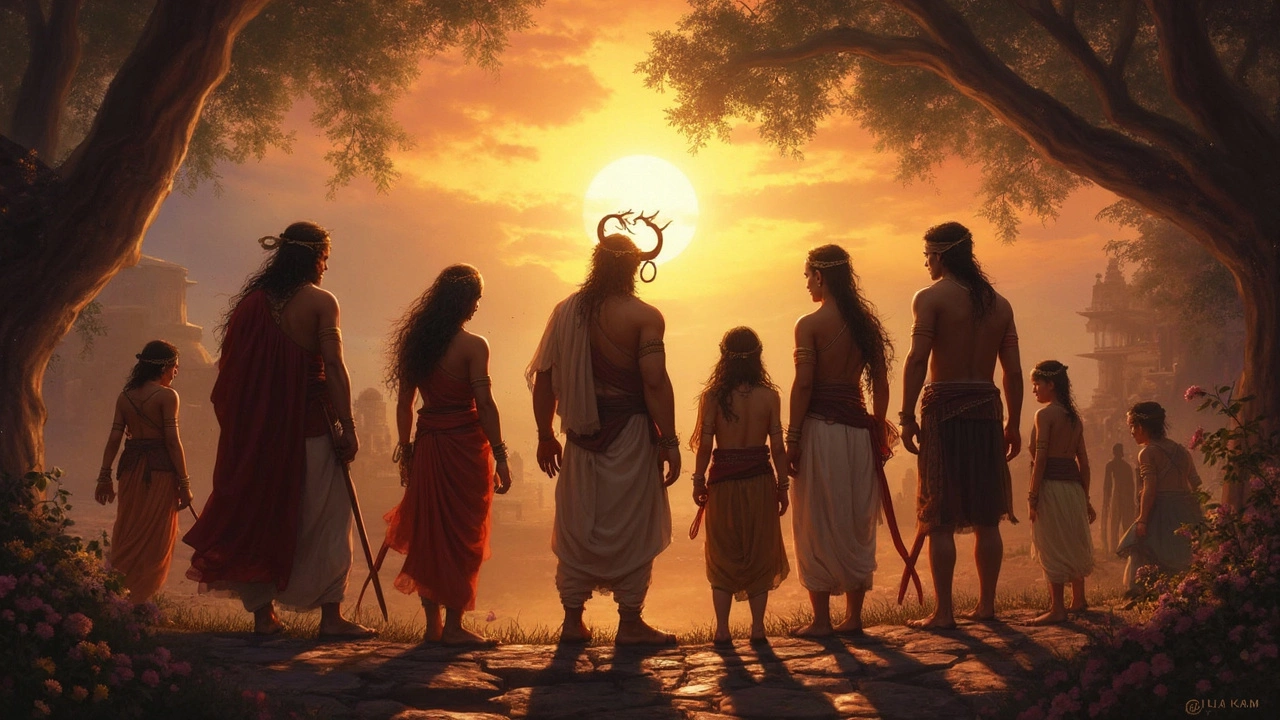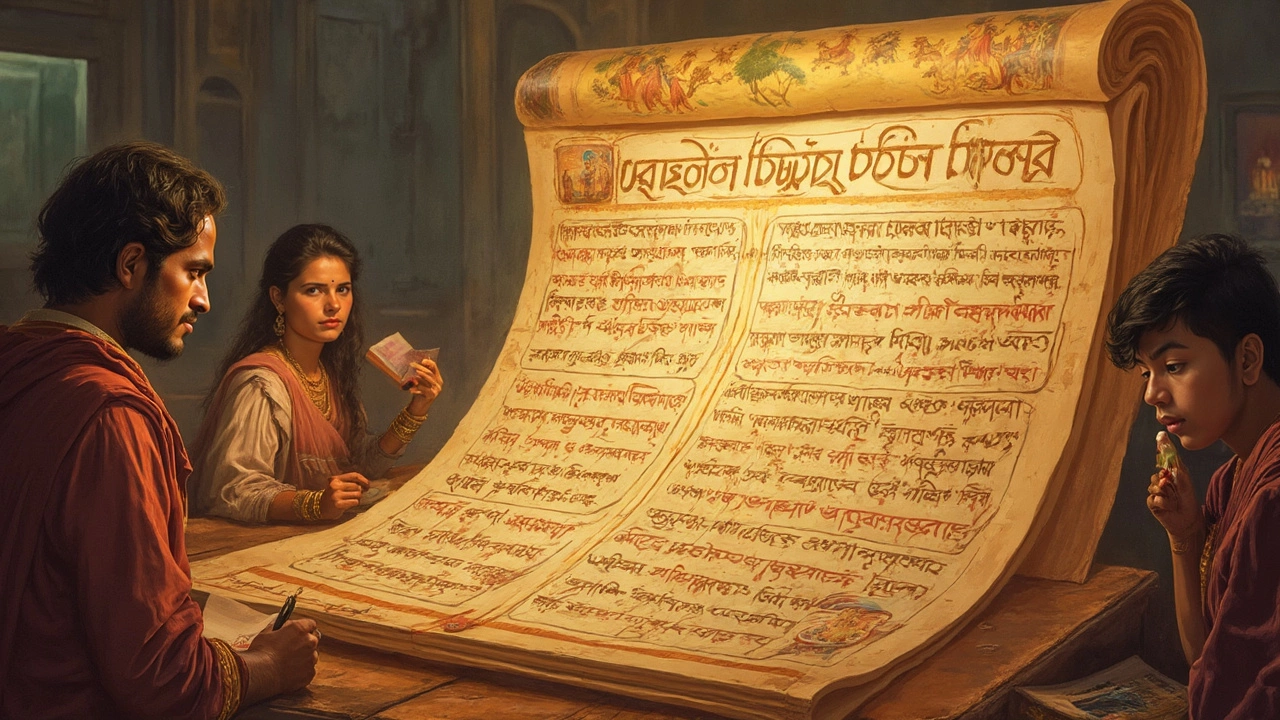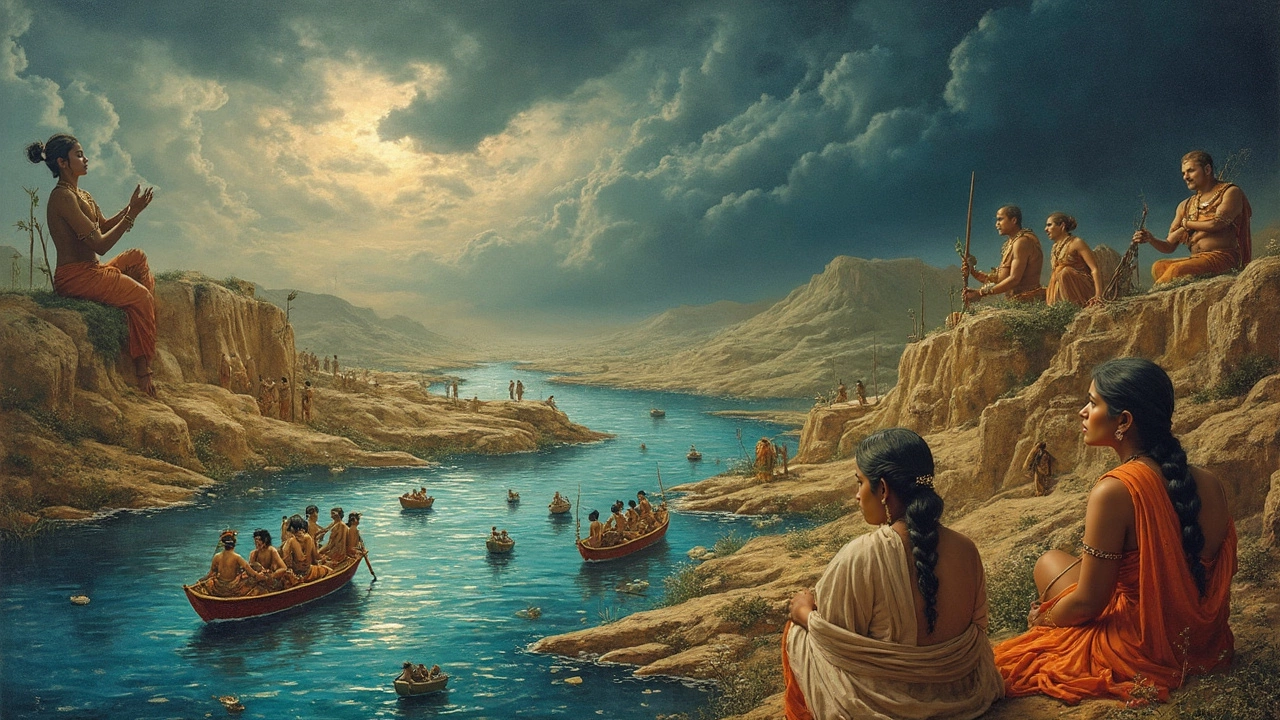Longest Epic Poem in India: Mahabharata’s Sad Poetry and Its Lasting Impact

You think you know long poems? The Mahabharata blows everything else out of the water. We’re talking close to 100,000 verses—ten times the length of the Iliad and the Odyssey put together. It’s not just trivia; this tells you just how important stories are in Indian culture. Scroll through the pages (or these days, hit up a translation online) and you’ll drown in heartbreak, betrayal, and impossible choices.
People often expect old Indian stories to be sunny tales of gods and miracles. The Mahabharata flips that on its head. The biggest chunk of India’s storybook is honestly about pain, uncertainty, and homes torn apart by war. And yeah, that’s what makes its poetry stick. It’s raw, complicated, and you can see echoes of its sad verses in everyday life—even if you’re just arguing with your sibling or guilt-tripping over a tough call at work.
- Why Is Mahabharata So Long?
- Sadness and Tragedy in Mahabharata
- Real-Life Lessons from its Poetry
- How to Start Reading Mahabharata
- Modern Echoes of Its Themes
Why Is Mahabharata So Long?
If you're hunting for the longest epic poem, nothing tops the Mahabharata. This thing is massive—around 100,000 shlokas (that’s poetic verses), which can mean over 1.8 million words. Just for comparison, the Bible is around 800,000 words. So why is it so huge?
First off, it’s not just one story. The Mahabharata is like a giant story sandwich: tales inside other tales, dozens of mini-dramas, full-on side quests, and major speeches packed in everywhere. The main plot follows the war between two royal families, but while you’re on that track, the poem keeps tossing new stuff at you—ancient legends, lists of kings, spiritual advice, and sometimes even how-to guides on building cities or running kingdoms.
Another big reason for its length is how it grew. The Mahabharata wasn’t written in one shot. Over centuries, storytellers and poets added their own episodes, teachings, and twists. Whenever something new was happening in society, someone would drop that into a chapter. Think of it like a really old forum thread that just keeps getting longer.
One more thing—lots of Indian philosophy and religion ended up in this poem. Stuff like the Bhagavad Gita (about 700 verses) is actually a little piece of the Mahabharata. If you’re looking for Hindu ideas about life, duty, and sadness, you’ll find pretty much everything hiding somewhere in these pages.
| Epic Poem | Estimated Verses | Word Count |
|---|---|---|
| Mahabharata | ~100,000 | 1.8 million |
| Iliad (Greek) | ~15,700 | ~155,000 |
| Odyssey (Greek) | ~12,000 | ~120,000 |
| Bible (for comparison) | - | ~800,000 |
People sometimes joke that nobody finishes reading the Mahabharata. The truth? Its size comes from generations of people plugging in what mattered to them—stories, advice, even warnings—so everyone could find something that hit close to home.
Sadness and Tragedy in Mahabharata
Reading the Mahabharata feels like sitting through a series of gut punches. The whole story centers on a huge family war—between the Pandavas and Kauravas—but the fights aren’t just on the battlefield. Everyone’s stuck in impossible situations, picking between bad and worse.
One of the most famous sad scenes is Draupadi’s humiliation in the royal court. She’s dragged in front of everyone, gambled away in a dice game by her husbands, while nobody steps up to protect her. It’s a real look at how pride, power, and silence can ruin lives.
Then there’s Bhishma, the grand old warrior. He chooses to die on a bed of arrows. Bhishma’s story stings because he spends his life trying to keep promises that, in the end, just bring more pain to his family.
Let’s talk numbers for a minute. The Mahabharata records the deaths of more than 1.6 million people in its war chapters, at least by classical accounts. No happy ending for most characters here. Even the winners, the Pandavas, are left with grief, loneliness, and regret.
| Character | Personal Loss / Tragedy |
|---|---|
| Draupadi | Lost her sons, was publicly humiliated |
| Bhishma | Lived and died upholding harsh vows |
| Karna | Rejected by his birth mother, died misunderstood |
| Duryodhana | Obsessed with revenge, died with little honor |
| Pandavas | Won the war, but lost almost everyone they loved |
If you’re interested in sad poetry India style, the way the Mahabharata spells out regret, missed chances, and pain is super clear. Even big heroes spend pages lamenting their mistakes. You’ll spot verses about mothers crying for kids lost in war, brothers torn apart by jealousy, and winners who feel hollow inside.
This is why the longest epic poem doesn’t feel distant—it’s loaded with sadness you can actually relate to. Doesn’t matter if it’s 2,000 years ago: heartbreak, guilt, and loss never really change.

Real-Life Lessons from its Poetry
If there’s one thing you can count on, it’s that the Mahabharata doesn’t pull any punches with life lessons. The epic is loaded with situations that feel too real: regret, sibling rivalry, guilt after making a bad decision, and the pain of losing people you love. Honestly, it’s a goldmine for anyone looking for practical advice hidden inside heartbreaking stories.
Take the famous story of Arjuna freezing up on the battlefield. He’s basically having a panic attack, worried about fighting family and friends. Instead of shoving his emotions down, he stops, talks it out, and the whole Bhagavad Gita gets born. How’s that for dealing with anxiety? The message: sometimes, feeling broken or stuck isn’t weird—it’s actually how most people feel when things get tough.
Let’s get even more concrete. The Mahabharata shows again and again that decisions have consequences, often for generations. Yudhishthira’s one mistake in a dice game drags his whole family into exile and war. The tip here? Don’t let peer pressure rush your choices. Pause and think; it’s not just you who pays the price.
The epic also hammers home how complicated “right” and “wrong” can be. It’s not your usual superhero tale. You see people doing the best they can with what they have—sometimes, it goes wrong. Bhishma’s loyalty leads him to stay silent during big injustices, and he spends the rest of his life carrying that burden. That tells you: staying quiet in the face of problems doesn’t equal peace. It often brings heavy regret.
Feeling isolated? Draupadi gets publicly humiliated and her so-called protectors freeze. She’s furious, devastated, but she speaks up. Her strength turns things around and later becomes a symbol for resilience. That’s an upfront lesson about standing up for yourself, no matter how alone you feel.
Check out this quick breakdown of the most recognized takeaways from the longest epic poem in India:
- Big choices have ripple effects—sometimes farther than you imagine.
- There’s courage in admitting fear and confusion.
- “Moral grey areas” are part of real life; rarely is an answer black or white.
- Owning up and speaking out matters more than just hoping things fix themselves.
People have actually run workshops and team-building sessions using scenarios from the Mahabharata to teach these points. Schools in India sometimes use select stories to talk about ethics because the lessons hit harder when you realize the characters aren’t so different from us. If you want life advice that goes beyond Instagram quotes, those sad, messy stories in the Mahabharata offer the real deal.
How to Start Reading Mahabharata
The Mahabharata’s sheer length is the first wall you’ll hit. Nobody expects you to read all 100,000 verses in one go—or ever. If you’re curious where to begin, here’s what really works for most folks today.
- Decide the Format: You’ve got choices. There are full translations, abridged versions, and tons of summaries. Penguin has one by C. Rajagopalachari that slices out the fluff. R.K. Narayan’s retelling is popular too. If you want just the bones of the story and the sad poetry India vibes, these are perfect for a start.
- Pick a Good Translation: Not all versions have the same mood. Some translators cut the tough, emotional parts. Bibek Debroy’s translation is known for sticking closer to the original, including the raw, sad moments that made the longest epic poem a classic.
- Read in Chunks: Don’t aim for more than a section or two at a time. The Mahabharata is divided into 18 books, called parvas. Start with the Sabha Parva (the famous dice game scene) or the Stri Parva (the aftermath of war, loaded with grief). These give you the core drama and emotion up front.
- Use Modern Summaries: If you get lost, check online summaries or YouTube explainers. They break down the highlights, character conflicts, and emotional low points.
| Popular English Versions | Author / Translator | Why Start Here? |
|---|---|---|
| Abridged (Penguin) | C. Rajagopalachari | Short, clear, covers key sad and dramatic parts |
| Unabridged | Bibek Debroy | True to the original Doesn’t skip emotional depth |
| Retold | R.K. Narayan | Simple language, easy to follow |
Quick tip: If you’re mainly into the tragic elements—the crushing grief, regrets, and broken families—focus on sections featuring Draupadi, Karna, or the Stri Parva. This way, you get that heavy sad poetry India flavor without wading through every single battlefield detail.

Modern Echoes of Its Themes
It’s wild how something written thousands of years ago still gets people talking today. You see themes from the Mahabharata in your favorite Netflix dramas, old Bollywood movies, and even the news. The ideas about loyalty, fighting with family, and the cost of ambition are everywhere. It’s like this ancient epic poem predicted how people would mess up and deal with regret, no matter the century.
Some of India’s biggest TV shows are just retellings of the Mahabharata. The 1988 Doordarshan series is one of India’s most-watched shows ever—it brought people together for weekly viewings and got everyone talking about the story’s tragedies. Writers like C. Rajagopalachari and Devdutt Pattanaik have modern retellings in bookstores, and you’ll find lecture series on YouTube breaking down what the story says about tough choices and sadness.
The poem’s sadness isn’t just history class material. Indian politicians, CEOs, and school kids still quote the Mahabharata when talking about duty, family arguments, or where things went wrong. Instagram influencers share lines from the epic during breakups or bad days. Even outside India, people find something to relate to in the tragic stories—just look at global talks on karma and justice inspired by these old verses.
| Fact | Where It Shows Up Now |
|---|---|
| Family disputes | Indian TV soaps & legal cases |
| Quotes about fate/destiny | Social media, political speeches |
| Stories of tough choices | Business ethics training, movies |
So if you think these old poems are just for classroom debates, think again. They’re woven into how people talk about life’s messiest problems—sometimes without even realizing it. That’s what keeps the Mahabharata and its sad poetry right in the middle of India’s biggest conversations—even today.